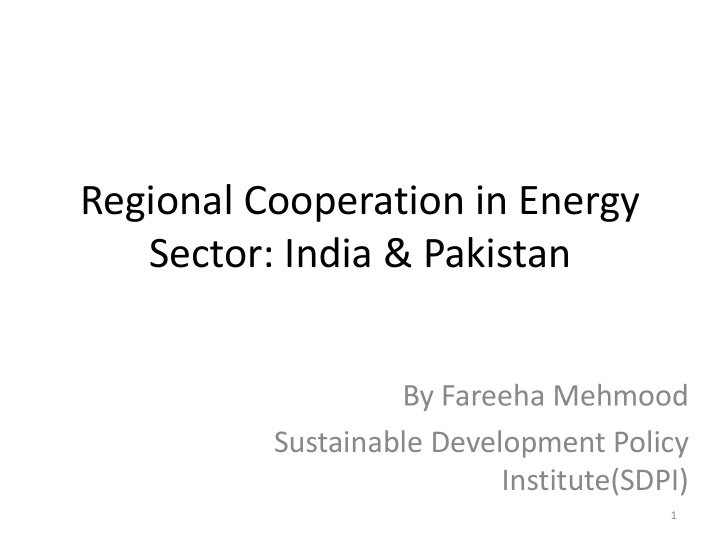



Regional Cooperation in Energy Sector: India & Pakistan By Fareeha Mehmood Sustainable Development Policy Institute(SDPI) 1
Outline • Energy Scenario across South Asia • Need for Energy Cooperation across South Asia • Importance of Bilateral Cooperation between India & Pakistan • Areas of Cooperation between the two Countries 2
Energy Demand across South Asia • Southeast Asia’s energy demand expected to increase by more than 80% in the period to 2035, a rise equivalent to current demand in Japan. • Currently the region’s per-capita energy use is still very low, in part because 134 million people, or over one-fifth of the population, lack access to electricity. • Oil is the dominant fuel, with demand currently around 4.4 mb/d, followed by natural gas, at 141 bcm. • Coal use has grown at double-digit rates since 1990 and now makes up 16% of primary demand. The share of renewables in the primary mix is almost twice the global average at 24% 3
Increased Energy Demands Increased dependence on Fossil Fuels Increased reliance on fluctuating oil prices Climate Change & its impacts Technological Barriers in RE & Economic & Political Uncertainties 4
Lack of Access to Adequate energy Energy In-secure South Asia resources at reasonable price(Energy insecurity) in Developing Economies Hampered Economic growth & Development Energy Poverty in Developing Countries (South Asian Countries) 5
Given the Scope & Geographic Extent of these issues, it calls for collective regional approach for implementing long term sustainable solutions 6
Objectives of Research Intends to explore the possible areas for bilateral cooperation Identify the areas for Mutual Cooperation for improving energy supply & addressing climate change adversaries 7
COAL GAS Oil Nuclear HYDRO Wind/Solar/biomass Coal fired power plant in India caused 665.4 12% Energy million tons of CO2 emissions in 2011 & Basket of 2012 and this year 524 people died* of India sunstroke. 18% 58% 2% 1% 9% 8
RFO Nuclear Hydro Gas 29% 36% Energy Basket of Pakistan 32% 3% 9
Wind Energy: A Possible Area of Cooperation • India • Pakistan • • India with installed capacity of Pakistan has identified potential of 340,000 MW 19564MW lies at 5 th position across the globe • Pakistan has only recently ventured into the field of wind technologies • The wind power accounts for and to date has no significant large scale wind generation project in 8.5% of installed capacity & operation. generates 1.6% of total power • The energy generation through wind power in Pakistan in 2013 stands around 384,000KWh28 through Zorlu • 95% of the wind energy wind power project(0.75 MW) while development is concentrated 18 wind power projects of 50 MW in five states i.e. Tamil Nadu, each are underway. Gujarat, Maharashta,Rajashtan & Karnataka 10
Features of Wind Energy in Pakistan • Wind Speed 12 Mupandal, Tamil Nadu 10 Ahmedabad Gujarat 8 Gharo Pakistan 6 4 2 0 Jan Feb Mar Apr May Jun Jul Aug Sep Oct Nov Dec 11
Wind Direction 12
India: Leaders in Wind Market • India has a vast experience in this field and enjoys leading position in wind turbine manufacturing can guarantee excellent efficiency coupled with remarkable features within the wind corridor of Pakistan • Moreover, this joint venture will provide Pakistan an opportunity to learn from Indian experience and train their personnel in this regard 13
• The average tariff of wind is now cost- competitive, at around 4.6 INR (7.884 PKR), and this presents hope for the future where India could phase out its dirty coal energy and switch to wind and other renewable sources of energy. • Thus, both India and Pakistan need to harness their individual potential for clean energy sources. 14
Exporting 500-1000 80% of power MW to generated to Srilanka be taken by India while Erection of leave 20% in Turbine Preparation Pakistan of concrete Identification foundation of site for wind power Installation 15
Cooperation on Water Issues • Most eminent instances of water cooperation in South Asia is the Indus Water Treaty (1960) between India and Pakistan • Kishenganga Project & its impacts on Neelum River Projects • In purview of venturing mutual cooperation in energy sector and for procuring peace across South Asia, India may revisit this dam • Western Zone has unexplored potential of about 65000MW, but only 12% has been tapped so far. The small hydropower projects in the similar area are a cost effective energy solution with low maintenance fees in comparison to other technologies. 16
17
Conclusion • Hence both India & Pakistan by acting upon the principles of peaceful co-exsistence and betterment of their people should benefit from this opportunity, thus moving forward on the road to progress and prosperity 18
Recommend
More recommend